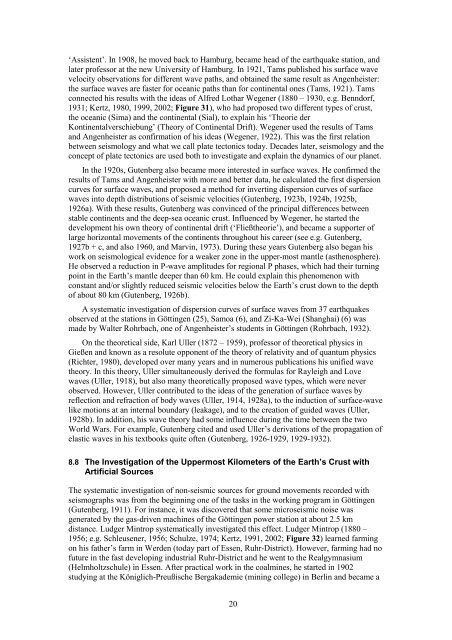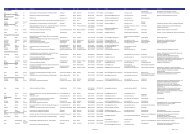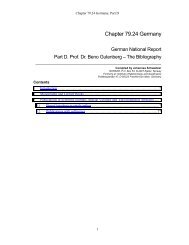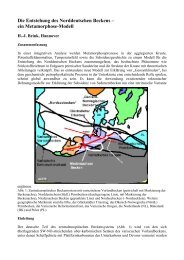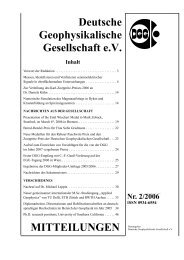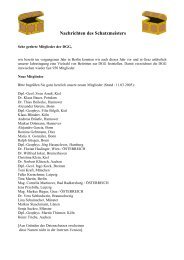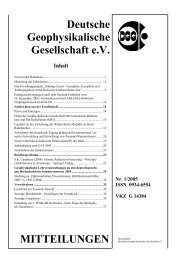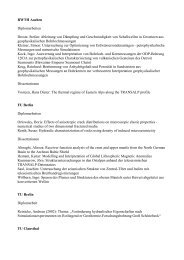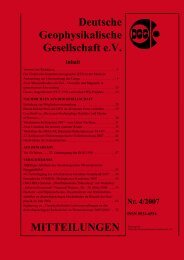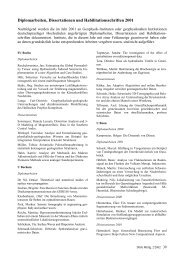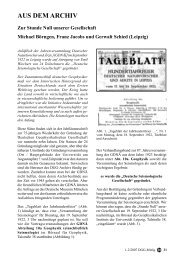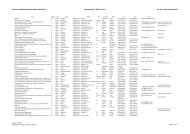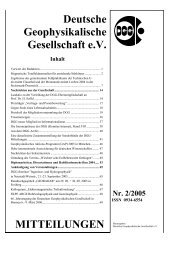Early Contributions to Modern Seismology - Deutsche ...
Early Contributions to Modern Seismology - Deutsche ...
Early Contributions to Modern Seismology - Deutsche ...
You also want an ePaper? Increase the reach of your titles
YUMPU automatically turns print PDFs into web optimized ePapers that Google loves.
‘Assistent’. In 1908, he moved back <strong>to</strong> Hamburg, became head of the earthquake station, and<br />
later professor at the new University of Hamburg. In 1921, Tams published his surface wave<br />
velocity observations for different wave paths, and obtained the same result as Angenheister:<br />
the surface waves are faster for oceanic paths than for continental ones (Tams, 1921). Tams<br />
connected his results with the ideas of Alfred Lothar Wegener (1880 – 1930, e.g. Benndorf,<br />
1931; Kertz, 1980, 1999, 2002; Figure 31), who had proposed two different types of crust,<br />
the oceanic (Sima) and the continental (Sial), <strong>to</strong> explain his ‘Theorie der<br />
Kontinentalverschiebung’ (Theory of Continental Drift). Wegener used the results of Tams<br />
and Angenheister as confirmation of his ideas (Wegener, 1922). This was the first relation<br />
between seismology and what we call plate tec<strong>to</strong>nics <strong>to</strong>day. Decades later, seismology and the<br />
concept of plate tec<strong>to</strong>nics are used both <strong>to</strong> investigate and explain the dynamics of our planet.<br />
In the 1920s, Gutenberg also became more interested in surface waves. He confirmed the<br />
results of Tams and Angenheister with more and better data, he calculated the first dispersion<br />
curves for surface waves, and proposed a method for inverting dispersion curves of surface<br />
waves in<strong>to</strong> depth distributions of seismic velocities (Gutenberg, 1923b, 1924b, 1925b,<br />
1926a). With these results, Gutenberg was convinced of the principal differences between<br />
stable continents and the deep-sea oceanic crust. Influenced by Wegener, he started the<br />
development his own theory of continental drift (‘Fließtheorie’), and became a supporter of<br />
large horizontal movements of the continents throughout his career (see e.g. Gutenberg,<br />
1927b + c, and also 1960, and Marvin, 1973). During these years Gutenberg also began his<br />
work on seismological evidence for a weaker zone in the upper-most mantle (asthenosphere).<br />
He observed a reduction in P-wave amplitudes for regional P phases, which had their turning<br />
point in the Earth’s mantle deeper than 60 km. He could explain this phenomenon with<br />
constant and/or slightly reduced seismic velocities below the Earth’s crust down <strong>to</strong> the depth<br />
of about 80 km (Gutenberg, 1926b).<br />
A systematic investigation of dispersion curves of surface waves from 37 earthquakes<br />
observed at the stations in Göttingen (25), Samoa (6), and Zi-Ka-Wei (Shanghai) (6) was<br />
made by Walter Rohrbach, one of Angenheister’s students in Göttingen (Rohrbach, 1932).<br />
On the theoretical side, Karl Uller (1872 – 1959), professor of theoretical physics in<br />
Gießen and known as a resolute opponent of the theory of relativity and of quantum physics<br />
(Richter, 1980), developed over many years and in numerous publications his unified wave<br />
theory. In this theory, Uller simultaneously derived the formulas for Rayleigh and Love<br />
waves (Uller, 1918), but also many theoretically proposed wave types, which were never<br />
observed. However, Uller contributed <strong>to</strong> the ideas of the generation of surface waves by<br />
reflection and refraction of body waves (Uller, 1914, 1928a), <strong>to</strong> the induction of surface-wave<br />
like motions at an internal boundary (leakage), and <strong>to</strong> the creation of guided waves (Uller,<br />
1928b). In addition, his wave theory had some influence during the time between the two<br />
World Wars. For example, Gutenberg cited and used Uller’s derivations of the propagation of<br />
elastic waves in his textbooks quite often (Gutenberg, 1926-1929, 1929-1932).<br />
8.8 The Investigation of the Uppermost Kilometers of the Earth’s Crust with<br />
Artificial Sources<br />
The systematic investigation of non-seismic sources for ground movements recorded with<br />
seismographs was from the beginning one of the tasks in the working program in Göttingen<br />
(Gutenberg, 1911). For instance, it was discovered that some microseismic noise was<br />
generated by the gas-driven machines of the Göttingen power station at about 2.5 km<br />
distance. Ludger Mintrop systematically investigated this effect. Ludger Mintrop (1880 –<br />
1956; e.g. Schleusener, 1956; Schulze, 1974; Kertz, 1991, 2002; Figure 32) learned farming<br />
on his father’s farm in Werden (<strong>to</strong>day part of Essen, Ruhr-District). However, farming had no<br />
future in the fast developing industrial Ruhr-District and he went <strong>to</strong> the Realgymnasium<br />
(Helmholtzschule) in Essen. After practical work in the coalmines, he started in 1902<br />
studying at the Königlich-Preußische Bergakademie (mining college) in Berlin and became a<br />
20


